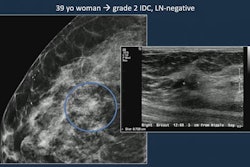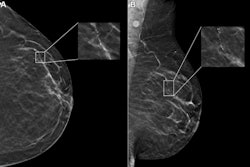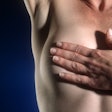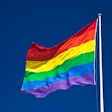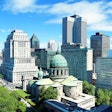Weekend and evening appointment availability for mammograms could improve screening access for women, according to research published May 24 in the Journal of the American College of Radiology.
A team led by Joanna Rossi, MD, from Johns Hopkins University in Baltimore, MD, found that women who are younger than age 50, of a race other than non-Hispanic white, non-English speakers, and from less advantaged zip codes are more likely to attend weekend and evening screening mammography appointment times.
“This data is in alignment with the increasing percentages of total screening mammograms scheduled on weekends or evenings at our institution since 2019 with implications that persistent and possibly increased demand exists in our population for screening appointments outside of normal business hours after post-COVID-19 volume recovery,” the Rossi team wrote.
Women may face one or more barriers to attending their regular breast cancer screening. These include a lack of a regular referring provider, lack of health insurance that covers screening, limited access to transportation, and challenges with appointment scheduling, among others.
Johns Hopkins’ health system recently began offering additional evening and weekend appointments for screening mammography. This is one strategy employed by the health system to mitigate screening disparities.
The Rossi team identified which women use weekend and/or evening appointments for screening mammography versus standard appointment times. It gathered data across four outpatient facilities in the Johns Hopkins academic health system.
The study included data collected between 2015 and 2022 for 203,101 screening mammograms from 67,323 women. It defined screening appointments as “standard appointment time” (between 8 a.m. and 5 p.m. on Monday through Friday) or “weekend/evening appointment time” (scheduled after 5 p.m. on Monday through Friday or at any time on a Saturday or Sunday).
Of the total screening mammograms, 91.3% (n = 185,436) were performed at standard appointment times while 8.7% (n = 17,665) were performed during weekends and evenings.
The researchers noted that when mammography services reopened in the summer of 2020 following a temporary cessation due to the COVID-19 pandemic, the health system increased the availability of evening and weekend mammography screening. This led to an increase in the annual percentage of all screening mammograms performed during these times between 2020 and 2022.
| Comparison of annual percentage of all screening mammograms, pre- and post-COVID-19 pandemic | |||
|---|---|---|---|
| Time frame |
Standard appointment time |
Evening/weekend appointment time |
p-value |
| Prepandemic |
95% |
5% |
N/A |
| Postpandemic |
86% |
14% |
< 0.001 |
The team also used multivariate analysis to find out which women are more likely to use evening and weekend appointment times compared with standard appointment times. It reported that the following women used the evening and weekend times more: women who were younger than age 50 (p < 0.001), a race other than non-Hispanic white (p < 0.001), non-English speakers (p < 0.001), and from less advantaged zip codes (p < 0.03). Meanwhile, women who are ages 70 and above, are non-Hispanic white patients, English speakers, and from the most advantaged zip codes were more likely to use standard appointment times.
The study authors wrote that more research is needed to further characterize barriers to breast cancer screening. However, they highlighted that their results showed “significant predictors” of utilizing evening and weekend screening.
“Therefore, in the current post-COVID-19 period, continuing and possibly expanding the number of weekend and evening appointment times would be anticipated to facilitate screening mammography uptake and adherence in our population for patients in every demographic including those patients reporting a race/ethnicity other than white,” the authors wrote.
The full study can be found here.






